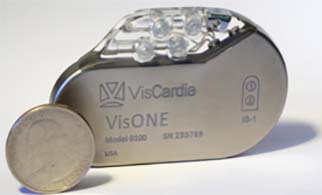
VisCardia has announced the first implant of its VisONE implantable system for heart failure, and the commencement of its VisONE Heart Failure pilot study in Ukraine. According to a press release, the VisONE implantable system delivers VisCardia’s proprietary asymptomatic diaphragmatic stimulation therapy to improve cardiac function. By electrically stimulating the diaphragm in an asymptomatic manner, transient intrathoracic pressures gaited to cardiac activity are applied against the cardiac walls, improving both cardiac filling and output.
The implant took place at the Heart Institute, Kyiv, Ukraine, under the leadership of Institute Borys Todurov and principal investigator Vitaliy Demyanchuk. The patient, a 53-year-old male with a reduced ejection fraction of 17%, remained in symptomatic heart failure despite an optimally titrated medical regimen, and had no alternative treatment options.
General surgeon Oleksandr Plehutsa, who performed the laparoscopic implant, comments: “The practicality and expediency of this novel and minimally invasive approach reduces critical anaesthesia times for this delicate heart failure population, enabling a quicker recovery versus established medical device therapies.” Furthermore, Todurov notes: “We are excited at the potential of this therapy to address a significant gap in clinical care. Our centre will be actively and methodically studying its impact on heart failure.”
Paul Erne (University Hospital of Basel, Basel, Switzerland) states: “During this 12-month pilot study, we are optimistic VisONE will deliver comparable benefits as those observed during our ADS feasibility studies.”
Echocardiographic data will be analysed at the University Hospital of Zurich under the direction of Felix Tanner, with statistical analysis performed at the Robertson Centre for Biostatistics in Glasgow under the guidance of John Cleland.
Michael Mirro, VisCardia’s Director of Medical Affairs, comments: “Given the promising evidence to date, it is exciting to see two recognised groups engaged in studying this new therapy with the proper clinical rigor of a multicentre study used by prominent heart centres.”









